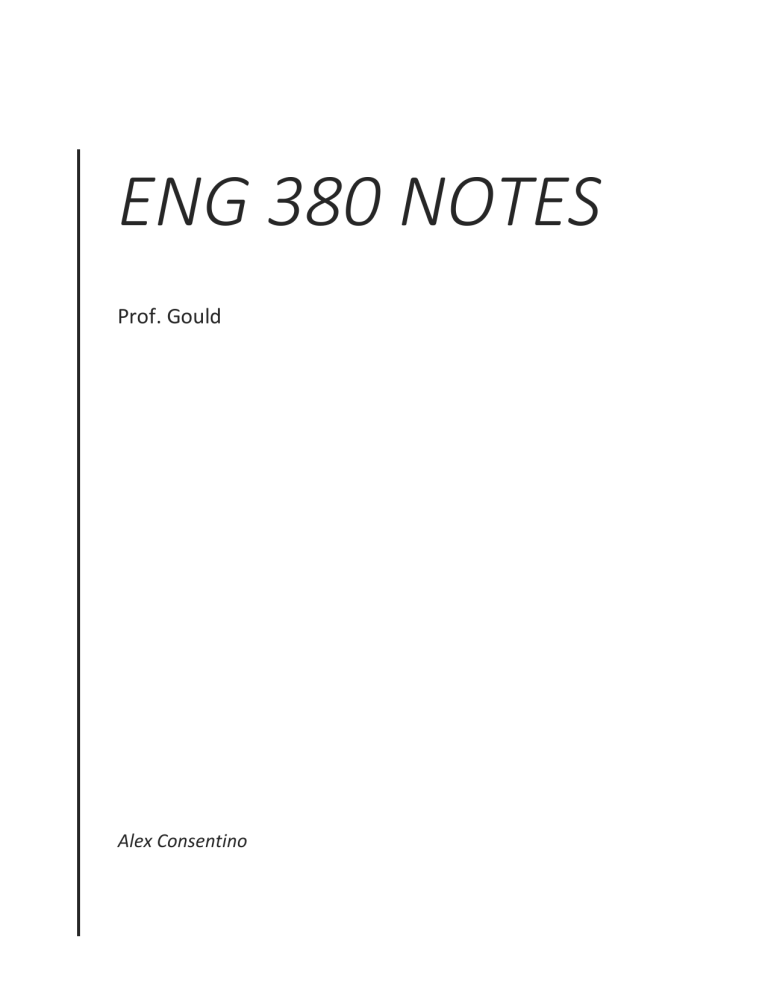
ENG 380 NOTES Prof. Gould Alex Consentino Eng 380 ................................................................................................................................. 2 Jan 11 ............................................................................................................................................2 Jan 13th .........................................................................................................................................3 Four major sources ..............................................................................................................................................3 Antoine Galland ...................................................................................................................................................3 Structural issues ...................................................................................................................................................3 Jan 18th HW notes -reading the spectator.......................................................................................3 Jan 18th class notes .......................................................................................................................4 Acts of union 1707 ...............................................................................................................................................4 Addison’s “The Spectator” ...................................................................................................................................4 Jan 20 reading hw ..........................................................................................................................4 Class notes Jan 20th ........................................................................................................................5 Stereotypes ..........................................................................................................................................................5 Self Other ....................................................................................................................................................5 Edward Said .....................................................................................................................................................5 Stereotypes of Orientalism .............................................................................................................................6 Stereotypes associated with Muslims today ...................................................................................................6 Ottoman Empire...................................................................................................................................................6 Feb 1 reading Charoba ...................................................................................................................7 Class notes Feb 1............................................................................................................................7 Common themes and Abraham ...........................................................................................................................7 Understanding Charoba’s Character ....................................................................................................................7 Feb 3 class notes ............................................................................................................................8 The story of the two sisters ..................................................................................................................................8 Patter of threes ...............................................................................................................................................8 Levels of the story/ monsters ..........................................................................................................................8 Feb 8th class notes ..........................................................................................................................9 Frankenstien.........................................................................................................................................................9 Interpretation ..................................................................................................................................................9 Romanticism ....................................................................................................................................................9 Relation to Arabian Nights ..............................................................................................................................9 Creature or Monster .......................................................................................................................................9 Frankenstein’s view of the monster ................................................................................................................9 Feb 10th class notes ........................................................................................................................9 Frankenstein.........................................................................................................................................................9 Narrorators ......................................................................................................................................................9 Why Safie.......................................................................................................................................................10 Marry Wollstonecraft- Sexual Character............................................................................................................10 Topics ............................................................................................................................................................10 Feb 22nd ....................................................................................................................................... 10 Favorite place on campus ..................................................................................................................................10 Robinson Crusoe ................................................................................................................................................10 Traveling ........................................................................................................................................................10 Feb 24th ....................................................................................................................................... 10 Olaudah Equiano(1745-97) ...........................................................................................................................10 March 10th ................................................................................................................................... 11 Aladdin ...............................................................................................................................................................11 Evidence that Galland wrote the story ..........................................................................................................11 Evidence against him writing it .....................................................................................................................11 Ring Genie .....................................................................................................................................................11 March 17th ................................................................................................................................... 11 Rhetorical Analysis .............................................................................................................................................11 March 24th ................................................................................................................................... 12 Aladdin (2019) ....................................................................................................................................................12 Themes ..........................................................................................................................................................12 Costumes- Aladdin ........................................................................................................................................12 Genie scene-sound ........................................................................................................................................12 April 5th ....................................................................................................................................... 12 April 19th...................................................................................................................................... 13 Genie .............................................................................................................................................................13 Arabian nights ...............................................................................................................................................13 Sultan.............................................................................................................................................................13 Alibaba...........................................................................................................................................................13 how do you want to continue growing .........................................................................................................13 How to improve .............................................................................................................................................13 Eng 380 Jan 11 Genie-Aladin Alibaba- website Sultans of swing Goals for this semester, 1: maintain a good GPA in the class and not fall behind on the readings and assignments 2: develop a stronger understanding for literature as it’s not something I have a lot of experience with. Arabian nights reading Jan 13th Susanians Two sons, chahiria worthy Schahzenan prince Describer as alf Layla wa Layla – a thousand different stories Book starts in Persia, goes to arabia, then to india and china Four major sources Persia 9th-10th century Baghdad stories 10th-12th centuries Cairo stories 12th-14th Orphan stories added by Antoine Galland 18th Cairo stories had more involvement with magic (genie stories) Antoine Galland 20 years in Constantinople collecting manuscripts Begins to translate and publish in 1704 First 7 volumes wildly successful, ended up with 12 volumes Took some liberties with his translation Met with Syrian monk in Paris and added stories but proofs aren’t known Most known stories aren’t known if popular stories are actually Arabic or not Edward Lane, Richard Burton, John Payne Most recent translator of the stories Structural issues Stories and nights not aligned- leaves cliff hanger Repetition Dinarzade repeating the same ideas Themes Frame tale- one story that has others embedded, layers that allow parallels to develop Jan 18th HW notes -reading the spectator The general, statesman, philospopher are characters we may never resemble, but the dying man is one whom we will all resemble Antiphanes quote about not grieving over death but completing ones journey and that we will join the deceased soon in a great places of gathering Jan 18th class notes Acts of union 1707 Unites Scotland and England Addison’s “The Spectator” Everyone wanted to be upper-class Was supposed to educate people Especially women “enliven morality with wit, and temper wit with morality” The speaker is Mr. Spectator, combines narratives, philosophies, and personal observations to offer advise and reflections on society. The goal of the book was to make people more educated and have insight into the desireable upper class. Part of being education is having a world perspective and living outside of the realm of ones current reality. What brings you into the story, what does it make you reflect on? The introduction imposes the notion of that while he is a famous writer and philosopher and writer, he comes into the coffee shop every day just as these people who are reading the spectator thus removing himself from his prestigious role and becoming a normal person. The moral makes one think that while you may not be rich and famous, what you complete on your journey is more important than wealth and notoriety. Death is the all equaling factor, and when ones time comes, other shall look back on if you completed your Jan 20 reading hw The Orient was Orientalized not only because it was discovered to be “Oriental” in all those ways considered common place by an average nineteenth-century European, but also because it could be-that is, submitted to being-made Oriental I myself believe that Orientalism is more particularly valuable as a sign of European-Atlantic power over the Orient then it is as a veridic discourse about the Orient (which is what, in its academic or scholarly form, it claims to be). The idea that the Orient was static and unmoved by the forces of modernity directly fed the myth of the supposed “Oriental mind.” Because “Orientals” had remained stuck in a stage of intellectual, cultural, religious, and political development essentially unchanged since the days of the pharaohs, Orientalists felt confident in making sweeping pronouncements about how modern-day peoples of the region thought and acted. There was no need to speak to contemporary people living in Egypt, Iran, or Arabia, because all one ever needed to know about them could be found in the treasure of ancient artifacts and manuscripts that Orientalist anthropologists, historians, and philologists eagerly devoured. Thus, there was an eternal and fixed “Oriental mind.” And, in the Orientalist interpretation, this “Oriental mind” was incapable of the kind of objectivity and rationality that would enable the people of the region to develop enlightened European institutions like science, representative democracy, capitalism, and the rule of law. Instead, it was and would forever be rooted in the subjective and transactional mental structures of the ancient world. Therefore, as a people, “Orientals” were vengeful, emotional, dishonest, and violently obsessed with shame and honor. In its methodology, Orientalism was highly textual, relying heavily upon ancient writings and inscriptions as the source of all knowledge about the Orient. This approach contributed to the dehumanizing tone and attitudes that pervaded so much of Orientalist discourse, treating human beings—indeed, even enormously complex human societies—as reducible to what texts had to say about them. For the Orientalist, the story of the East was fundamentally one of texts—not people. This methodology had real-world consequences, as Orientalists sought to apply ancient texts to address the problems of the modern Orient, fully consistent with their belief in an unchanging East—and in their unique role as its interpreters. Class notes Jan 20th Stereotypes Imagined geography is a perception of area that is derived form stories myths and tales from that place that combines into a stereotype o Orient- French term, to describe countries to the east where the sun rose o Carried across to Brittan o Term shifted to all of western culture is Asia and middle east Self Other o Creating sense of identity, by defining differences or “I am not” Edward Said o Born in Jerusalem in 1935 o Professor of literature at Columbia o Activist o Orientalism is used in a variety of fields, not just literature “An entrenched structure of thought or patter of thinking that generalizes and misrepresents the non-western world in order to hold power over it” Stereotypes of Orientalism It will be clear to the reader (and will become clearer still throughout the many pages that follow) that by Orientalism I mean several things, all of them, in my opinion, interdependent. The most ‘read adily accepted designation for Orientalism is an academic one, and indeed the label still serves in a number of academic institutions. Anyone who teaches, writes about, or researches the Orient-and this applies whether the person is an anthropologist, sociologist, historian, or philologist-either in its specific or its general aspects, is an Orientalist, and what he or she does is Orientalism. (pg. 10 E-text) o o o o o o o Despotic in positions of power Sly in positions of service-cannot be trusted Sexually perverse Women locked up Mystical religious devotees incapable of rationality Stuck in the past Exotic Related to this academic tradition, whose fortunes, transmigrations, specializations, and transmissions are in part the subject of this study, is a more general meaning for Orientalism. Orientalism is a style of thought based upon an ontological and epistemological distinction made between “the Orient” and (most of the time) “the Occident.” Thus a very large mass of writers, among whom are poets, novelists, philosophers, political theorists, economists, and imperial administrators, have accepted the basic distinction between East and West as the starting point for elaborate theories, epics, novels, epics, social descriptions and political accounts concerning the 11 Orient, its people, customs, “mind,” destiny, and so on…. the phenomenon of Orientalism as I study it here deals principally, not with a correspondence between Orientalism and Orient, but with the internal consistency of Orientalism and its ideas about the Orient (the East as career) despite or beyond any correspondence, or lack thereof, with a “real” Orient. Stereotypes associated with Muslims today o Terrorists o Veil o Violence o Sharia Law o Radical or fanaticism o Misogynist o Oppressed women o Isolated o Backwards and uneducated Modern day stereotypes 9/11 Bin Laden 1798-Napoleon enters Egypt Ottoman Empire Very aggressive Europe was afraid of the Ottomans One of the most powerful countries 1583- queen Elizabeth the 1st set up trading with the Ottoman Empire o They agreed they had more religious ideals in common than France o They believed Catholics were worshiping Idols 1699- treaty of carlowitz o Ottomans agree to a boundary o Set up flourishing trading o Sparked fascination of Arabian Culture Feb 1 reading Charoba Charoba is daughter of king totis (Egypt) Sarah wife of abraham After Totis’ death, Charuba inherits the throne, but a tribe of giants settles in Egypt and threatens to usurp the kingdom. As a ruse, Charuba demands from the king of the giants, Gebirus, to build a city on the place of Alexandria. During the day the giants build the city, but at night nymphs from the Nile destroy it, so as to endlessly postpone the completion of the town. Then a shepherd falls in love with one of the nymphs. Gebirus dresses himself as the shepherd and finds out the secret of Charuba. The tale is not a pastiche of the Thousand and one nights, but contains several motifs of Nights’ stories, such as the giants, the jinniyyas and the king dressing up as a poor lad. Class notes Feb 1 Common themes and Abraham Morality lesson to learn commitment, authority monotheistic worlview bible interpritation understainding Abraham, the patriarch islam, jusaism, christianity Understanding Charoba’s Character Evil Poisoning the king Good Honors his death She deceived him when she poisoned him Engraves his name Gave him his last words Sends Abraham gifts, shows generosity, Snuck unwanted items in the treasure Contrasted with father as peaceful Pg 209-211 Feb 3 class notes The story of the two sisters Patter of threes Pearls boundires/ containment names Pattern of 3's mosnters objects Levels of the story/ monsters Level 1 Scheherazade and Schahriar o The sultan- his actions against women turn him into a monster His behavior and lack of morality Level 2 The three sisters Sultaness and Khosrouschah o The sultaness becomes the monster Stories told about her/ prejudices Not a monster in terms of behavior o Stories told lead to prejudice Level 3 Stories of the Children o The appearance Needed a haircut Feb 8th class notes Frankenstien Interpretation Robert Walton o Viktor Frankenstien -telling stories The monster/creature Romanticism Literary movement from 1770-1850 Begun in Britain Turned towards nature and the interior world of feeling o In opposition of formalism and enlightenment that proceeded it Relation to Arabian Nights Frame tale Education and women Repetition Creature or Monster Maker o Intricacies, process, human materials Machine Parts vs whole 8ft tall o Large in every aspect Like himself/ god complex o Image of creator Animal/ human Frankenstein’s view of the monster He thinks is beautiful before it becomes alive But its alive he freaks out Feb 10th class notes Frankenstein Narrorators Walton- letters o Frankenstein- simple narration Creature/ Monster – oral stories Safie- letters Why Safie At the time there was still a strong fascination with the orient. The story includes so much magic and mysterious acts similar to those found in stories told of the orient at the time. Thus tying in an Arabic woman makes this stories mystique. Marry Wollstonecraft- Sexual Character Topics Feb 22nd Favorite place on campus My favorite place has to eb heroes garden, I always feel so peaceful when I go up there due to its beauty and its secludedness from campus. Furthermore the meaning behind it adds an additional aura to its mystique Robinson Crusoe Traveling Brazil o London o Hub for the story o Home o Origin point o Barbary coast/ Morocco African coast Ocean o Crusoe offers everything for his salvation o Slavers capture him o He is inexperienced o Seeks those with more knowledge Feb 24th Olaudah Equiano(1745-97) Born in modern Nigeria and sold into slavery at age 11 Spent time on plantations in Barbados and Virginia before being sold to british naval officer Final master allowed him to buy his freedom Became a merchant and explorer Published the interesting narrative in 1789 o Swayed public opinion on slavery Spiritual autobiography Slave narrative Examines different religions Hypocrisy of Christianity His conversion Different appeal to the audiences emotions-> sentimentality Descriptions of instances of violence Separation Desire for education and freedom March 10th Aladdin Evidence that Galland wrote the story Heavier on stereotypes Collapsing identities Dramatic and exotic o Vague descriptions, location, heavy emphasis on magic) Depiction of women o oppressed and sexualized obsession with wealth Rags to riches o Common trope in fairy tales Evidence against him writing it Patterns Magic Intertextuality Ring Genie Enormous size Beat down Slave Doesn’t think independently March 17th Rhetorical Analysis Bush 9/11 speech “We will direct every resource at our command--every means of diplomacy, every tool of intelligence, every instrument of law enforcement, every financial influence, and every necessary weapon of war--to the destruction and to the defeat of the global terror network.” (Bush pg 4 paragraph1) Repetition Parallelism o To show that we are going to put everything into this o Maximum effort o Emphasis on the full effort of the American people/ government “This is not, however, just America's fight. And what is at stake is not just America's freedom. This is the world's fight. This is civilization's fight. This is the fight of all who believe in progress and pluralism, tolerance and freedom.” (Bush pg. 4 paragraph 9) Anaphora o Showing that this is the worlds fight, for those who believe in ced morals Repetition President Bush’s use of parallelism and anaphora’s stress the fact that the United States is not alone in the fight against terrorism alongside our governments full commitment to protect the freedom and sovereignty of the American people. March 24th Aladdin (2019) Themes Costumes- Aladdin Long messy hair Dirty clothes Rolled up sleeves Tattered hat Wears opposite as monkey Genie scene-sound Mysterious music Bellowing voice in the beginning Once he addresses Aladdin the music shifts Floating noises as the Genie moves around April 5th It is apparent that this isn’t spying in the traditional james bond sense, rather in a more litetal application. By putting these descriptions in the voice of someone other than himself, it makes it feel more mysterious and adds an additional element to the story that makes the reader become more involved on a greater level. April 19th Genie Large magical creature that originally portrayed as a monster Arabian nights A compilation of stories forma variety of regions including areas that aren’t Arabic Sultan the king in the arabian nights Alibaba the story how do you want to continue growing I learned a lot about the prejudices that western ideologies promote about middle eastern and Asian cultures. I found myself backtracking on facts that turned out to be mis-portrayed and or false aspects that were made up in the sake of How to improve Pay more attention, focus on getting assignments in early rather than last minute
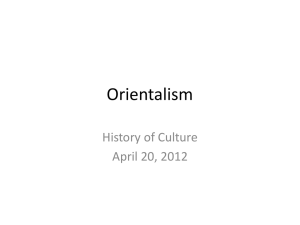
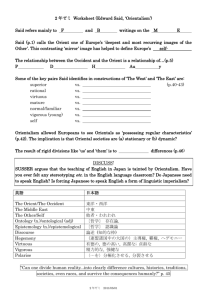
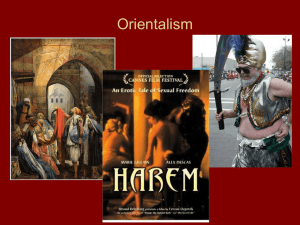
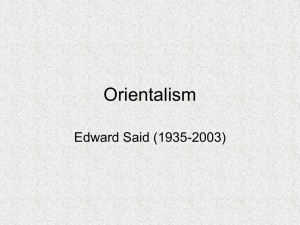
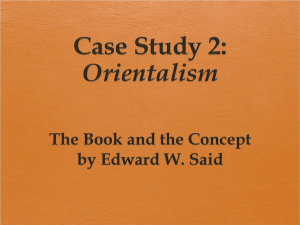
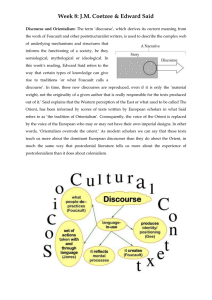
![Orientalism PPT[1].](http://s3.studylib.net/store/data/009508903_1-bf40dd03912d19b9c9baea1f12c90f25-300x300.png)